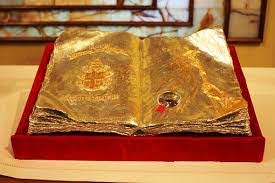
The word relic, derived from the Latin word reliquiae which means remains, holds an important place in the history of many religions. They refer to the physical remains or personal belongings of a saint, preserved for the purpose of veneration. Relics in Christianity have been found, revered, and even duplicated to preserve a connection to one’s faith.
There are hundreds of Christian relics found around the world, but most of them are concentrated in Italy, France, or Jerusalem. Building your trip around these locations is a great idea if you wish to do follow the trail of holy relics. Here are 6 places that you must visit to witness Christian relics from your own eyes.
Turin, Italy
It is worth visiting Turin for the sole purpose of witnessing the Shroud of Turin through your own eyes. The 14-foot linen cloth is one of the most discussed, researched, and reverent icons in the history of relics. It is said to be the burial shroud of Jesus Christ himself and reflects the story of Christ. The shroud was found in Lirey, France by a knight in the 1350s. 600 years later, the shroud has been declared as an icon and not a relic, sold to Italy, studied for hours on end. Recently, the shroud of turn was even moved to the digital age due to the COVID-19 pandemic.
If you hop on the trail to discover relics, Turin, specifically the Cathedral of St. John the Baptist, is undoubtedly the first place you should visit. While visiting the cathedral, also known as the Cathedral of Turin, you can also witness the tomb of Blessed Pier Giorgio Frassati whose body was said to be incorruptible. This means that the bodies were unaffected by natural decomposition and to this day, retain their prior state.

Jerusalem
Considered one of the holiest places for a multitude of religions, the aura of Jerusalem would transport you to an atmosphere of reverence and the presence of higher power. The burial slab of Jesus Christ was uncovered in 2016 by archeologists. The slab is found under the Church of the Holy Sepulchre which was built upon the traditional place of crucifixion and burial of Christ. The slab was recently discovered after the tomb was opened for the first time in 2016 to undergo restoration. The Church of the Holy Sepulchre also contains some of the most popular relics of all time. The Rock of Calvary encased atop the altar of Crucifixion is also located on the grounds.
If you wander outside on the grounds, there is still plenty of relics to stumble upon. One such relic is contained in the Chapel of the Finding of the True Cross below the Chapel of St. Helena. This chapel contains the cross-use for the crucifixion which was located by St. Helena, the mother of Constantine the Great. Aside from this, you can witness the Prison of Christ, Franciscan area tomb of Joseph of Arimathea.

Rome, Italy
Rome is the seat of Catholicism and Christianity. It houses the four major basilicas and the Vatican City which is ruled by the pope. While there are much grandeur and opulence to witness in the place, the relics in the Basilica of San Giovanni in Laterno or St Johns Lateran are the most stunning preservations. The church is built upon the barracks of Constantine’s pagan enemies and consecrated in 318 and is often known as the mother of all churches, even St. Peter’s Basilica in Vatican City. Here, you can see the High Altar, made of wood and believed to be the one used by St. Peter used during the celebration of mass. Near the altar, you will also notice columns holding a Gothic structure containing the heads of the Apostles- Paul and Peter.
The Holy Stairs are one of the main attractions whose relocation took place from Jerusalem to Rome by St. Helena and is believed to have been the one that Jesus Christ himself stepped on. Finally, the main attraction of the Church is the sculpture of the Last Supper. This sculpture weighs 1000 pounds and is gilded in silver. It is famously known as a part of the table used for the Last Supper.
While, in terms of relics, the church should definitely be your first visit, when in Rome, there are several other holy places you can visit as well. Vatican City and the other three major basilicas, namely the Basilica of St. Peter, the Basilica of St. Paul Outside the Walls, and the Basilica of St Mary Major. Furthermore, you can make the experience more divine by visiting during one of the holy days or festivities to see the place come alive with spirit.

Paris, France
Paris might be the city of love but it also a hotspot for Christian relics that date back centuries. One of the most notable accumulations of these is the relics of St. Chapelle. These were originally 22 in number, part of the Passion relics, and collected and preserved by St. Louis. Throughout the ages, they diminished and now there are only three. These include a fragment of the cross of Jesus Christ, a nail from the crucifixion, and the crown of thorns. Out of these, the most notable, the Crown of Thorns was said to be put atop Christ’s head during the events leading up to the crucifixion. This achieved the means to cause pain to Christ and as a mockery of his authority. Today, you can see all three of the remaining relics at the Notre-Dame Cathedral where it was shifted.
You can also venture deeper into the reliquaries by traveling to some tombs and chapels of the saints. The patron saint of the city, St. Genevieve has a chapel dedicated to her burial site and the location of her finger bone at St. Etienne-du-Mont church, next to the Pantheon. Furthermore, a Christian pilgrimage site, the Saint Vincent de Paul chapel is where the Saint Catherine Laboure was enshrined. Her body is incorrupt and the holy status arises from the fact that the saint had seen visions of the Virgin Mary during her stay.

Pittsburgh, Pennslyvania
The Chapel of St. Anthony was created by Suitbert Mollinger for the sole purpose of rescuing relics from around the world. Therefore, it is no surprise that today, it houses around 5000 relics that stand for the bits and pieces that connect to the old world and religion. Pittsburgh definitely brings forth a more accessible collection and an all-in-one place approach. You are sure to experience the full force of the Christian spirit when you visit the church covered from top to bottom with gold and jewel crusted reliquaries. It is the second-largest collection, aside from the private one in Vatican City.
The collection boasts authentic splinters from the True Cross and the Column of Flagellation and a stone from the Garden of Gethsemane. Also in the collection is the nail that held Christ to the Cross, and material from Jesus, Mary, and Joseph’s clothing. Furthermore, a piece of bone from all the apostles is a great subject of interest. You can visit the relics from St Therese of Liseux, St. Rose of Lima, St. Faustina, and St. Kateri Tekawitha. The whole of St. Demetrius’ body is also found under the altar, in a glass sarcophagus for all the witnesses. However, the most impressive of the lot is the tooth of St. Anthony of Padua, which is the only one of his remains to be found outside his home town in Italy.

Naples, Italy
The relic stored in Naples is studied almost as much as that of the Shroud of Turin and is definitely bizarre and miraculous. The Blood of St. Januarius or St. Gennaro, found in the Chapel of the treasury in the Cathedral of Naples, has a confounding composition. While blood normally coagulates or spoils after death, this particular relic seems to liquefy even after 600 years. Till today, the blood has liquefied 18 times a year in its entire history. In the same cathedral, you will also find the bones of St. Januarius along with the head that is kept in a silver bust and away from the other two relics. The liquefaction is performed as a ceremony, three times a year. The few times that it has failed to do so have often clashed with natural disasters such as famine or war.
Another mystifying relic, though not as celebrated as the blood of St. Januarius, is from the St. Thomas Aquinas. The remains of the left arm of the saint are found in the Basilica of San Domenico Maggiore. Upon entering the church, you will easily locate the arm along with a small piece of bone encased in a hand-shaped reliquary. You can peep into it to witness the relic for yourself. The architecture and the presence of the relic impose on the atmosphere of Naples, perfect for travelers seeking Christian relics from the past.


